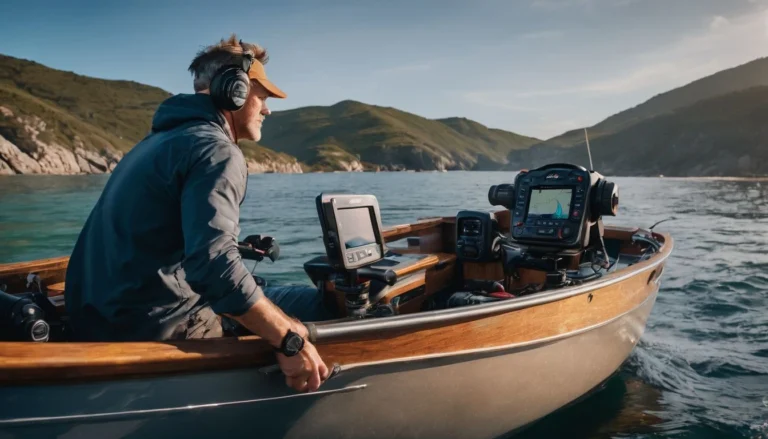How to Enter Coordinates in Garmin Fish Finder?
Figuring out how to enter coordinates into a Garmin fish finder can feel like a daunting task for many anglers. The Garmin Striker 4 Plus, known for its precision and user-friendly features, stands ready to enhance your fishing expeditions.
This article is designed as a lifeline, offering step-by-step guidance on inputting coordinates and marking waypoints so you can focus more on the catch than the tech.
Dive in and discover an ocean of navigational ease!
Key Takeaways
- To enter coordinates into a Garmin fish finder, use the arrow keypad to navigate and mark your desired location on the map, then input precise latitude and longitude numbers.
- You can create a new waypoint for a non-current position by selecting ‘User Data’ and entering the exact GPS coordinates into designated fields for both latitude and longitude.
- View your waypoints on the map page of the Garmin Striker 4 Plus to track progress toward your fishing targets, with options available to edit or add new waypoints using GPS data.
- Always ensure you have installed the correct fuse size, typically between 1 and 3 amps, for your Garmin fish finder to protect it from electrical damage.
Understanding the Garmin Fish Finder
The Garmin Fish Finder is a tool that has revolutionized the way anglers explore marine environments. Designed to detect underwater structures, it’s perfect for navigating lakes filled with man-made features and natural obstacles like trees and brush piles.
The Striker 4 Plus model, in particular, offers crisp visuals that help users pinpoint exactly where fish are hiding. With its user-friendly interface, even those who aren’t very adept with electronics can learn to use this device effectively.
Mastering your Garmin Fish Finder takes practice but provides invaluable assistance in your fishing ventures. You’ll soon find yourself identifying key spots without any guesswork involved—may it be tracking down schools of fish or marking potential hotspots for future visits.
As you become familiar with these capabilities, moving on to the next step—inserting specific latitude and longitude coordinates—becomes an essential skill for creating precise navigation maps.
How to Place a Waypoint at Specific Latitude and Longitude Coordinates?
Setting up your Garmin fish finder to navigate to precise fishing spots is straightforward once you know how to input the exact latitude and longitude into your device. Whether it’s a secret sweet spot or a new area you’re keen to explore, entering coordinates directly will have you casting lines right where the fish are biting.
Using the arrow keypad
To use the arrow keypad on your Garmin fish finder, you’ll need a steady hand and a bit of patience. Start with your device turned on and in navigation mode. Use the arrow keys to move the cursor across the map display until it hovers over the exact spot where you want to drop a waypoint for your marine adventure.
Pressing ‘Enter‘ marks that location in your system; now you’re set to enter the specific latitude and longitude coordinates. Make sure each digit is precise—marine electronics require accuracy for successful navigation! Adjust numbers using up or down arrows, then lock them in with another press of ‘Enter’.
This process allows Douglasdzaster and others like him, who are new to their Garmin devices, seamless control over their navigational destinations while out at sea.
Entering the coordinates
Entering coordinates into your Garmin fishfinder is a straightforward process that can significantly enhance your fishing experience. Simply power on your device and access the ‘Waypoint Map‘ or ‘Navigation‘ menu to get started.
From there, select the option to create a new waypoint, where you’ll be prompted to input the specific latitude and longitude details of your desired location.
Ensure accuracy by carefully typing in each number; even a small mistake can lead you miles off course. After entering the correct numbers, confirm or save this information. Your Garmin will then acknowledge the new waypoint, adding it to your map for future reference as you navigate lakes with their unique underwater landscapes designed by Parks and Wildlife efforts.
With these coordinates set, the focus shifts from finding spots to optimizing fishing strategies around these waypoints.
Creating a Waypoint at a Different Location
In the realm of precision navigation, sometimes you’ll need to mark a spot in the water that’s not in your current position. Our Garmin Fish Finders excel at this task, enabling anglers to input coordinates and chart a course to uncharted fishing territories with ease.
Selecting ‘User Data’
To create a map with important fishing spots, like those man-made structures and brush piles Douglasdzaster is targeting, you’ll need to select ‘User Data‘ on your Garmin fish finder.
This feature allows you to manage all the waypoints, routes, and tracks that are crucial for navigation. Begin by accessing the main menu and navigating to the appropriate section where user data is stored.
Once there, choose ‘Waypoints,’ which will let you input new coordinates or modify existing ones tailored specifically for your fishing journey. You can directly input latitude and longitude details, ensuring each spot gets precisely marked on your lake map.
It’s an efficient way to have all your favorite locations saved and easily accessible while out on the water.
Entering coordinates
After you’ve accessed ‘User Data‘ on your Garmin fish finder, it’s time to pinpoint the exact location using coordinates. First, select the option for entering latitude and longitude on your device.
You’ll see two fields where you can input these figures accurately. Carefully type in the numbers for latitude first, making sure every digit is correct; then do the same for longitude.
Precision is key; a single mistake could send you off course.
Once you enter both sets of numbers, confirm that they match your intended destination’s GPS coordinates. Your fish finder will save this information as a new waypoint that guides you to structures and brush piles beneath the water’s surface without any guesswork involved.
This tool is especially helpful if technology isn’t your strong suit, but exploring hidden lake treasures is what ignites your fishing passion.
Displaying the position or coordinates on the map page
Once your Garmin Striker 4 Plus has a waypoint set, you can easily see where it is on the map page. Just power up your device and use the keypad to navigate to the map screen. Here, all of your waypoints will show up as small icons that are simple to identify.
Tap one of these icons, and a box pops up with the exact latitude and longitude for that spot.
You’ll also have the option to view your current position in real-time. Keep an eye on this information as you move around the lake; it’s key for staying oriented among trees and underwater structures.
The coordinates update automatically, letting you track progress towards any waypoints or spots marked by Parks and Wildlife at all times. Enjoy precise navigation without guesswork—your fishing trips just got a whole lot smarter!
Creating and editing waypoints using GPS coordinates
After displaying the coordinates on the map, you may want to create and edit waypoints for easier navigation. With your Garmin Striker 4 Plus, marking significant spots on the lake is simple. Here’s how you can accomplish this using GPS coordinates:
- First, power on your Garmin fish finder and access the main menu by pressing the Menu button twice.
- Locate and select ‘Waypoint Map‘ or ‘Navigation‘ to bring up your current position.
- Push the ‘New Waypoint‘ option; a default waypoint will appear on screen.
- Select ‘Edit‘ to alter this waypoint’s details, including its name, for easy recall.
- Choose ‘Location‘ and manually input latitude and longitude coordinates using the keypad arrow keys for precision entry.
- Confirm each coordinate after entering it by selecting ‘Done‘ or pressing Enter.
- Save changes to store this new waypoint in your fishfinder system.
- Revisit the Waypoint Map from the main menu to see all saved waypoints.
- Scroll through your list of waypoints using the arrow keys until you find the one that needs editing.
- Highlight the chosen waypoint, then press ‘Enter‘.
- Pick ‘Edit Location,’ which might require confirmation before proceeding.
- Clearing prior numbers with Backspace/Delete, then proceeding as before with new data entries.
- Save them by selecting “OK” or “Done,” solidifying your modifications within the fish finder’s memory.
Choosing the Right Fuse Size for Your Garmin Fish Finder
Selecting the proper fuse size for your Garmin Striker 4 Plus is vital to safeguarding your device from electrical issues. It’s like picking the right-sized shield for a battle: too small, and it won’t protect you; too big, and it’s cumbersome.
For this model, you’ll typically need a fuse that can handle 1-3 amps of current. This ensures that the fish finder has enough power to operate effectively while protecting its intricate circuitry from potential overloads.
To install the fuse correctly, locate the power cable of your fish finder and find the inline fuse holder near its end. Carefully place a fuse with the recommended amperage into this holder before securing all connections.
With this simple step, you boost your device’s defenses against unexpected electrical spikes and ensure years of reliable performance on those exciting angling adventures amidst man-made structures where every correct navigation counts.
Conclusion
Navigating your Garmin fishfinder with precision is now within reach. Remember, whether you’re marking a waypoint or plotting a course to that secret fishing spot, it’s about tapping in those GPS numbers and letting the tech do its magic.
Dive into these steps, embrace the digital age on your aquatic adventures, and let every journey be as accurate as it is thrilling. Your next big catch might just hinge on hitting those coordinates, right?
Keep this guide handy, power up your Garmin, and set sail with confidence.
For guidance on selecting the appropriate fuse size for your device, check out our detailed article on choosing the right fuse size for your Garmin Fish Finder.
FAQs on Entering Coordinates in Garmin Fish Finder
Gary Burrell
Born in 1989, Gary Burrell is an Electrical Engineering graduate from the University of Tennessee. With 20+ years of experience, he has transitioned from engineering roles to becoming the Chief Content Editor. Gary’s unique blend of technical knowledge and editorial expertise has made him an essential figure in content creation, ensuring clarity and accuracy. His journey from an engineer to an editor showcases his adaptability and commitment to continuous learning.




